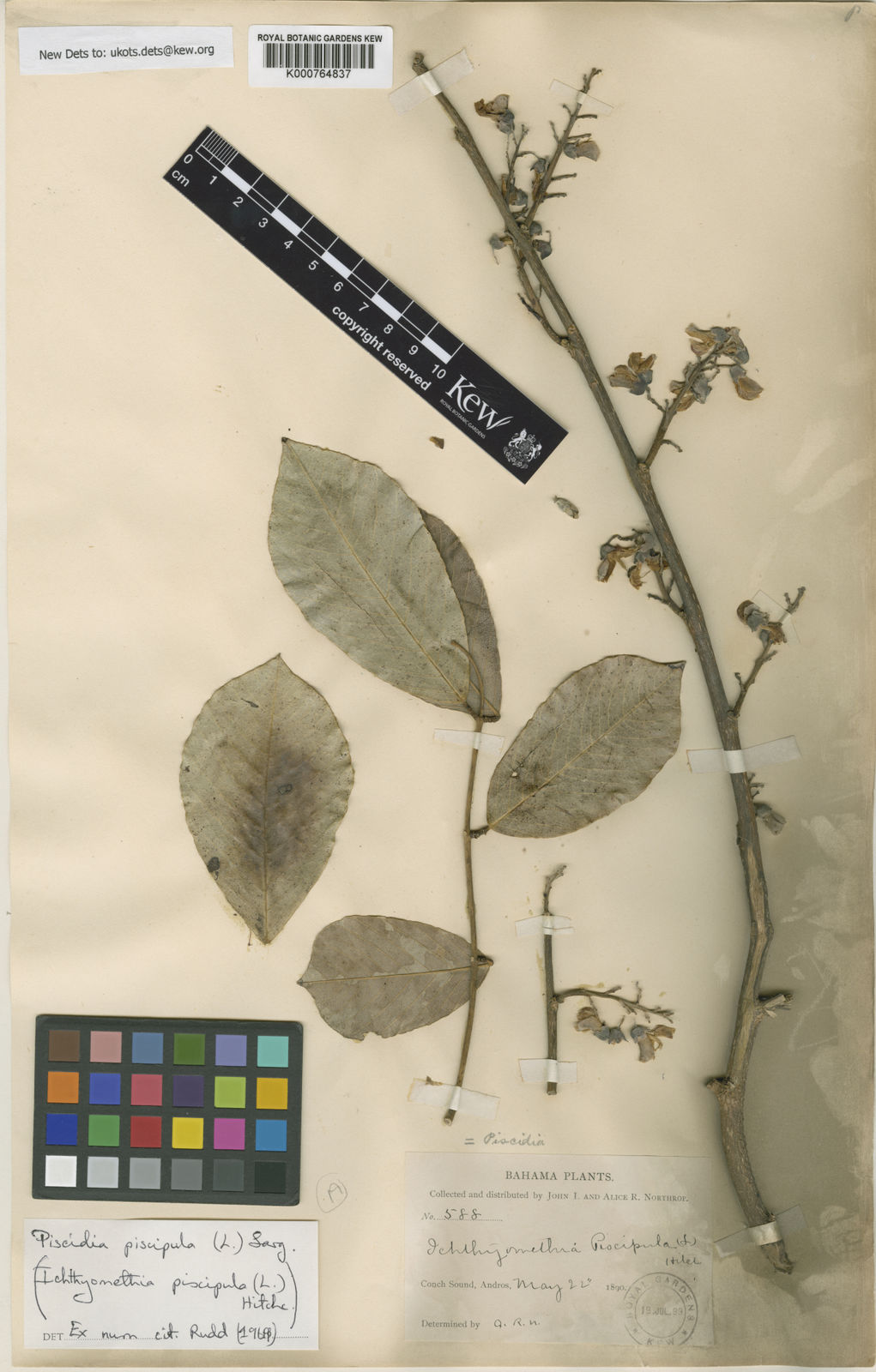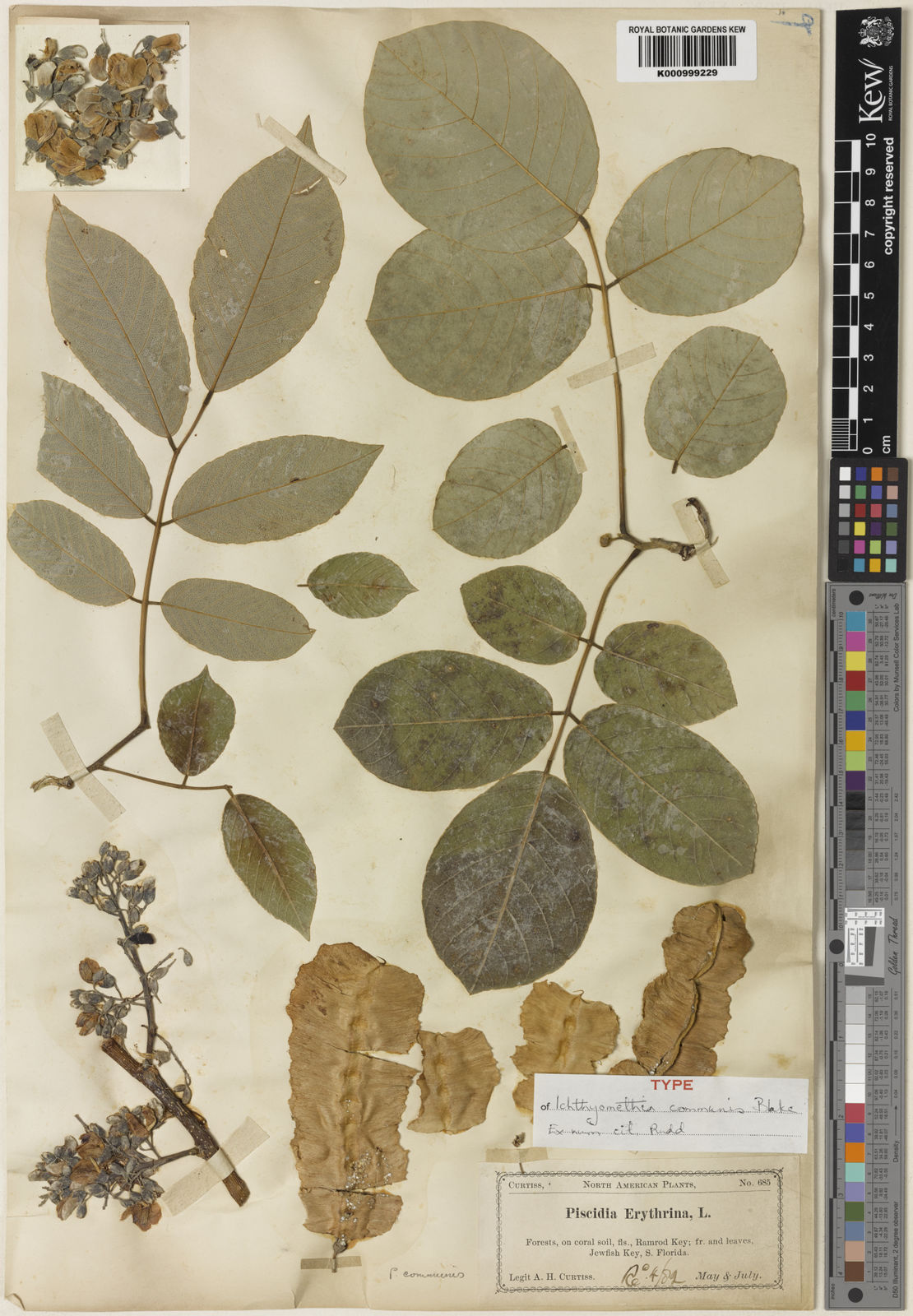Jamaica Dogwood
piscidia piscipula
Also known as: ["Dogwood","Fishfuddle","Piscidia tree"]
Overview
A deciduous tree native to the Americas, known for its toxic bark and roots used traditionally for fishing and medicinal purposes.
Benefits & Perks
["medicinal use","wildlife attractant (bees, butterflies, birds)"]
Botanical Classification
| Phylum: | Magnoliophyta |
| Class: | Magnoliopsida |
| Order: | Fabales |
| Family: | Fabaceae |
| Genus: | Piscidia |
| Botanical Name: | Piscidia piscipula |
Plant Characteristics
Basic Information
- Category: Trees
- Suitable Location: outdoor garden in warm climates, or large container in cooler regions
- Suitable For:
- Is Weed: No
- Allergenicity: moderate
Environmental Needs
- Climate: {"temperatureRange":"15–35°C"}
- Hardiness: {"zones":"9–11"}
- Misting: rarely required, only if ambient humidity is very low
- Drainage: Fast-draining to prevent waterlogging.
- Soil Type: Well-draining, loamy soil with added organic matter; cactus mix can be used with compost.
Maintenance Level
- Maintenance Level: moderate
- Toughness Level: moderate
- Pruning Frequency: Annually in late winter or early spring before new growth begins.
- Pruning Intensity: Moderate; remove up to one-third of old growth to rejuvenate the plant.
Care Details
Ideal Sunlight Coverage:
Full sun to partial shade; 6–8 hours of direct sunlight daily, with some afternoon shade in hot climates.
Sunlight Tolerance Tips:
Acclimate gradually to intense sunlight; protect from harsh afternoon sun to prevent leaf scorch; adjust placement based on indoor/outdoor conditions.
Care Requirements
Care Difficulty
moderatemoderate
Sunlight
full sun to partial shade
Rotate plant for even light exposure; use sheer curtains to filter intense sun; monitor for signs of sunburn.
Watering
every 7–10 days during growing season, reduce in winter
Water thoroughly until it drains from the bottom; allow soil to dry between waterings; avoid overwatering.
Soil
well-draining, loamy soil with moderate organic content
pH: Slightly acidic to neutral, pH 6.0–7.0.
Use raised beds for better drainage; avoid heavy clay soils; test pH periodically.
Temperature
Thrives in warm conditions, 65–85°F (18–29°C); tolerates brief periods of cooler temperatures but prefers stable warmth.
Protect from frost; avoid sudden temperature fluctuations; maintain consistent warmth during active growth.
Fertilizing
every 2–3 months during active growth
Apply fertilizer after watering to prevent root burn; flush soil occasionally to prevent salt buildup; adjust frequency based on growth rate.
Propagation
Methods
Stem cuttings or seeds; stem cuttings are more reliable for home growers.
Step-by-Step Propagation Guide
- Take a 4–6 inch cutting.
- Remove lower leaves.
- Apply rooting hormone.
- Plant in medium.
- Keep moist and warm.
Best Time: Spring or early summer when the plant is actively growing.
Environment
Warm, humid environment with indirect light; maintain consistent moisture.
Medium
Well-draining potting mix with perlite or sand; can also root in water initially.
Hormone
Rooting hormone is recommended to improve success rates.
Timeline
Roots may develop in 4–8 weeks; establishment in new pot takes 2–3 months.
Tools Needed
Pruning shears, rooting hormone, small pots, well-draining medium.
Quick Tips
Use healthy, non-flowering stems; maintain high humidity with a plastic cover; avoid direct sunlight.
Pruning & Repotting
Pruning Guide
Method
Selective thinning and heading back to shape the plant and improve air circulation.
Pruning Plan
Prune to maintain shape, encourage bushier growth, and remove dead or diseased wood.
Tools
Pruning shears, loppers (for larger branches), sterilizing solution.
Checklist
Sterilize tools; prune during dormancy; remove dead/diseased wood; shape evenly.
Repotting Guide
Best Season
Early spring before active growth starts.
Pot Size
Increase pot size by 2–3 inches in diameter; ensure good drainage holes.
Method
Remove plant gently; trim roots if necessary; place in new pot with fresh soil; water lightly after repotting.
Suggestions
Repot every 2–3 years or when roots fill the pot; necessary to refresh soil and provide space for growth.
Checklist
Check root bound status; prepare new pot with drainage; use fresh soil mix; water sparingly post-repotting.
Advanced Care Tips
Watering Mastery
Watering Checklist
Check soil moisture; water deeply; ensure drainage; adjust for season.
How to Apply Water Properly
Water directly at the root zone, ensuring even moisture distribution; water early in the morning to minimize evaporation; ensure excess water drains away to prevent waterlogging.
Watering Schedule Tips
Water deeply once the top inch of soil is dry; reduce frequency in winter to prevent root rot.
Soil Improvement
Add perlite or sand for drainage; incorporate compost for fertility; ensure soil is loose and airy.
Temperature Stress Management
Signs of Temperature Issues
Yellowing leaves, wilting, or bud drop in cold; leaf scorch or stunted growth in excessive heat.
Cold Stress
Slows growth, causes leaf drop, and may lead to root damage if temperatures drop below 50°F (10°C).
Solution: Move to a warmer location; provide frost protection; avoid watering during cold spells.
Hot Stress
Leaves may wilt, scorch, or drop; growth may slow due to excessive heat and water loss.
Solution: Provide shade during peak heat; increase watering frequency; use mulch to retain soil moisture.
Fertilizing Guide
Fertilizing Checklist
Check growth phase; dilute fertilizer; apply to moist soil; avoid winter feeding.
Fertilizing Method
Use balanced liquid fertilizer diluted to half strength every 4–6 weeks during growing season (spring to early fall); avoid fertilizing in winter.
Common Problems & Solutions
Toxicity Warning
Cats
ToxicCats are particularly sensitive to the toxic compounds in Piscidia piscipula, which can cause severe neurological and gastrointestinal symptoms. The plant's effects can be rapidly debilitating and potentially fatal.
⚠️ Symptoms:
🌿 Toxic Parts:
⚡ Toxic If:
if eaten
Dogs
ToxicDogs are highly susceptible to the toxic effects of Piscidia piscipula, which can lead to severe neurological and gastrointestinal distress. The alkaloids in the plant can cause sedation, paralysis, and respiratory failure in canines.
⚠️ Symptoms:
🌿 Toxic Parts:
⚡ Toxic If:
if eaten
Humans
ToxicPiscidia piscipula contains alkaloids that can cause significant physiological effects, including sedation, paralysis, and potentially fatal respiratory depression. The plant's roots and bark have been historically used in folk medicine but are highly toxic if ingested improperly.
⚠️ Symptoms:
🌿 Toxic Parts:
⚡ Toxic If:
if eaten
Frequently Asked Questions
Q: Is Jamaica Dogwood safe for pets?
A: No, it is toxic to dogs and cats.
Q: What are the traditional uses of Piscidia piscipula?
A: The bark and roots have been used traditionally for fishing (to stun fish) and in medicine for sedative and pain-relieving properties.
Q: How difficult is it to grow Jamaica Dogwood?
A: It requires moderate care and maintenance, suitable for intermediate gardeners.
Quick Reference
| Family: | Fabaceae |
| Care: | moderate |
| Light: | full sun to partial shade |
| Water: | every 7–10 days during growi |
Get Expert Care Tips
Download the Plantious app for personalized care reminders and plant identification!
Google Play App Store







